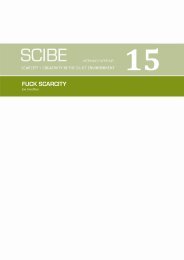Urban Scarcities: A Look at Shanghai - SCIBE
Urban Scarcities: A Look at Shanghai - SCIBE
Urban Scarcities: A Look at Shanghai - SCIBE
You also want an ePaper? Increase the reach of your titles
YUMPU automatically turns print PDFs into web optimized ePapers that Google loves.
8<br />
Deljana Iossifova<br />
with certain socioeconomic standing—a so-called ‘positional good’ 7 ). ‘When<br />
adapt<strong>at</strong>ion cre<strong>at</strong>es ever more wishes,’ Luks writes, ‘and when supply of<br />
certain goods cannot by definition meet the demand, there can be no end to<br />
scarcity. The promise of modernity with its emphasis on development,<br />
growth, progress and abundance cannot be fulfilled’ 8 . The city seems to be<br />
built on the promise of modernity.<br />
Embedded Inequalities<br />
Historically, independence and better incomes have been the factors th<strong>at</strong><br />
drew migrants from the countryside to the city 9 . The liter<strong>at</strong>ure suggests th<strong>at</strong><br />
migr<strong>at</strong>ion restrictions in China were relaxed in the l<strong>at</strong>e 1970ies in response<br />
to more than 150 Mio surplus labour in the countryside 10 . Initially<br />
welcomed as cheap and exploitable labour force, ‘farmers’ came to the city<br />
to find work in factories and <strong>at</strong> constructions sites. In <strong>Shanghai</strong> alone, the<br />
‘flo<strong>at</strong>ing popul<strong>at</strong>ion’ 11 today is estim<strong>at</strong>ed <strong>at</strong> 6.6 Mio, but certainly not<br />
considered welcome. CHX’s f<strong>at</strong>her, for instance, who had come to city from<br />
the countryside in the l<strong>at</strong>e 1940ies—a rural-to-urban migrant himself—and<br />
had lived in the pingminqu (A) ever since, thought of his neighbourhood as<br />
‘not quite as nice as before’: ‘small houses have turned into high-rises’, he<br />
said; but more importantly, ‘too many migrants [had arrived] from the<br />
countryside’ (Interview with CLS, September 2008).<br />
7<br />
P. Brickman and D. T. Campbell, ‘Hedonic Rel<strong>at</strong>ivism and Planning the Good Society’, in<br />
Adapt<strong>at</strong>ion-Level Theory: A Symposium (New York: Academic Press, 1971), pp. 287–302.<br />
8<br />
Fred Luks, ‘Deconstructing Economic Interpret<strong>at</strong>ions of Sustainable Development: Limits,<br />
Scarcity and Abundance’, in The Limits to Scarcity, ed. by Lyla Mehta, Science in Society (London<br />
& Washington, DC: Earthscan, 2010).<br />
9<br />
Milton Santos, ‘Space and Domin<strong>at</strong>ion - A Marxist Approach’, Intern<strong>at</strong>ional Social Science<br />
Journal, 27 (1975), 346-363<br />
[accessed 27 January<br />
2011].<br />
10<br />
Daniel Goodkind and Loraine A. West, ‘China's Flo<strong>at</strong>ing Popul<strong>at</strong>ion: Definitions, D<strong>at</strong>a and<br />
Recent Findings’, <strong>Urban</strong> Studies, 39 (2002), 2237 -2250<br />
.<br />
11<br />
Rural-to-urban migrants are officially excluded from public services such as insurance, health<br />
services, or educ<strong>at</strong>ion. See, for instance, Daniel Fu Keung Wong and He Xue Song, ‘The<br />
Resilience of Migrant Workers in <strong>Shanghai</strong> China: The Roles of Migr<strong>at</strong>ion Stress and Meaning of<br />
Migr<strong>at</strong>ion’, Intern<strong>at</strong>ional Journal of Social Psychi<strong>at</strong>ry, 54 (2008), 131-143<br />
.




